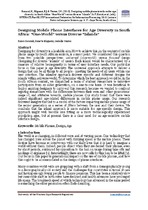| dc.contributor.author | Renaud, Karen | |
| dc.contributor.author | Blignaut, Renette | |
| dc.contributor.author | Venter, Isabella M. | |
| dc.date.accessioned | 2014-03-05T13:55:08Z | |
| dc.date.available | 2014-03-05T13:55:08Z | |
| dc.date.issued | 2013 | |
| dc.identifier.citation | Renaud, K., Blignaut, R.J, Venter, I.M. (2013). Designing mobile phone interfaces for age diversity in South Africa: “One-World” versus diverse “Islands”. In P. Kotzé, et al. (eds). INTERACT, Part III, IFIP International Federation for Information Processing 2013, Lecture Notes in Computer Science, pp. 1-17 , Cape Town, South Africa | en_US |
| dc.identifier.isbn | 978-3-642-40477-1 | |
| dc.identifier.uri | http://hdl.handle.net/10566/1050 | |
| dc.description.abstract | Designing for diversity is a laudable aim. How to achieve this, in the
context of mobile phone usage by South African seniors, is a moot point. We
considered this question from two possible perspectives: universal (one-world)
versus focused design (designing for diverse “islands” of users). Each island
would be characterised by a measure of relative homogeneity in terms of user
interface needs. Our particular focus in this paper is age diversity. The universal
approach attempts to deliver a design that can be all things to all people –
meeting the needs of all users within one user interface. The islander approach
delivers specific and different designs for islands within a diverse world. To
determine which the best approach would be, in the South African context, we
dispatched a team of student researchers to interview participants from an older
generation, on a one-to-one basis. It was beneficial to deploy aspiring designers
to carry out this research because we wanted to confront aspiring researchers
with the differences between their own and other generations’ usage of, and
attitudes towards, mobile phones. Our study found that there were indeed
significant age-related differences in mobile phone usage. Our research
delivered insights that led to a model of the factors impacting mobile phone
usage of the senior generation as a series of filters between the user and their
device. We conclude that the island approach is more suitable for age-specific
design. This approach might well become less fitting as a more technologically
experienced population ages, but at present there is a clear need for an agesensitive
mobile interface design. | en_US |
| dc.language.iso | en | en_US |
| dc.publisher | Springer | en_US |
| dc.rights | Author post-print of official article published by Springer. | |
| dc.source.uri | http://dx.doi.org/10.1007/978-3-642-40477-1_1 | |
| dc.subject | Mobile Phones | en_US |
| dc.subject | Design | en_US |
| dc.subject | Age | en_US |
| dc.title | Designing mobile phone interfaces for age diversity in South Africa: “One-World” versus diverse “Islands” | en_US |
| dc.type | Book chapter | en_US |
| dc.privacy.showsubmitter | FALSE | |
| dc.status.ispeerreviewed | TRUE | |

